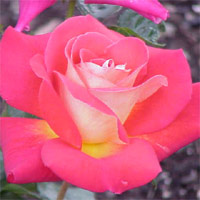Rose

Roses come in a huge range of sizes, shapes, and flower colors. A hugely popular plant, the rose is also our national floral emblem.
About This Plant
There is a rose for every garden situation and need, from climbers to adorn a trellis, to miniatures for containers, to long-stemmed types for bouquets. Because of this variety, it's important to choose carefully. If you are looking for the familiar rose bush, consider hybrid teas, floribundas, or shrub roses. Hybrid teas are tall, long-stemmed roses ideal for cutting. Floribundas are shorter and bloom more freely, setting clusters of blossoms rather than a single bloom on a stem. Both these require regular maintenance for optimum performance. Shrub roses (sometimes called landscape roses), on the other hand, require somewhat less attention, adapt more readily to a wider range of conditions, and offer more disease resistance.
Special Features
Fragrant
Good for cut flowers
Care
Apply a layer of compost under the shrub each spring, followed by a 2-inch layer of mulch to retain moisture and control weeds, keeping mulch a few inches away from the stems. Water plants during the summer if rainfall is less than 1 inch per week. Pruning techniques vary with the type of rose.
Site Selection
Select a site with full sun and well-drained soil.
Planting Instructions
Plant in early spring or fall, depending on your location. Space plants 2 to 3 feet apart, depending on the variety. Prepare the garden bed by using a garden fork or tiller to loosen the soil to a depth of 12 to 15 inches, then mix in a 2- to 4-inch layer of compost. In regions with cold (below 0F) winters, plant grafted roses so the graft union (which appears as a bulge near the base of the stem) is 1 to 2 inches below the soil line. In warm regions, the graft should be a few inches above the soil line.
For container-grown plants, dig a hole twice the diameter of the pot the plant is in. Carefully remove the plant from its container and place it in the hole. Carefully fill in around the root ball and firm the soil gently. For bare-root roses, dig a hole 12 to 18 inches deep and wide. The hole should be large enough that all the roots can be spread out without touching the sides of the hole. Mound a cone of soil in the center of the hole. Trim off any broken roots, then place the rose in the hole, spreading the roots around the soil mound. Fill the hole half full with soil and water it well to settle the soil and eliminate air pockets. Let the water drain, then fill the remainder of hole with soil and water thoroughly.






 Roses come in a huge range of sizes, shapes, and flower colors. A hugely popular plant, the rose is also our national floral emblem.
Roses come in a huge range of sizes, shapes, and flower colors. A hugely popular plant, the rose is also our national floral emblem.